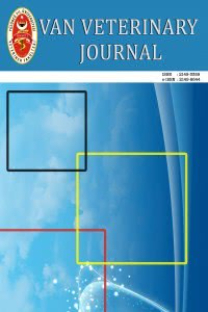Evaluation of nutritive value of forages grown around Van Lake
çayır mera bitkileri, hayvan besleme, yıkılma, yemler, istatistiksel analizler, Türkiye, kimyasal bileşim, yonca, besin değeri
Van Gölü havzasında üretilen kuru otların besleyici değerinin araştırılması
pasture plants, animal nutrition, degradation, feeds, statistical analysis, Turkey, chemical composition, lucerne, nutritive value,
___
1. A.OA.C (1980): Official Methods of Analysis (13 ^ Ed.). Association of Official Analytical Chemists, Washington DC.2. Broderick GA (1995): Desirable characteristics of forage legumes foT tmproving protein utilization in ruminants. J. Anim. Sci., 73:2760-2773.
3. Browo WC and Ptttman WD (1991): Concentmtion and degradation où nitrogen and fiber fractions in selected tropical grasses and legumes. Trop. Grassl., 25:305-312.
4. Bwx DR ted Ruæet JR 1988): Lgnin constituents and cell wall digestibility of grass and legume stems. Crop. Sci., 28:553-558.
5. Buxton DR and Brnsche MR (1991): Oigestibility of structural carbohydrates in cool-season grass and legume forages. Crop. Sci. 31:1338-1345.
6.8uzlon DR and Fales SL (1 94): Quantifying Forage Protein Quality. (in) Forage Quality, Evaluation, and Utilization. Fahey, G. C., Jr., (Editor), 200-229, American Society of Agronomy, Inc. Crop Science Society of America, Inc. Soil Science Society of America, Inc. Madison, WI.
7. Coblentz WK, Abdelgader IEO, Cochran RC, Fritz 3O, Fick WH, Olsen KC and Turner JE (1999): Degradability of forage proteins by in situ and in vitro enzymatic methods. J. Dairy Sci., 82:343-354.
8. Coblectz Wît, Fritz JO, Fick WX, Cochrsn RC, and Shirley 4E (1998): In situ dry matter, nitrogen, and fiber degradation of alfalfa, red clover, and eastem gamagrass at four maturities. J. Dairy Sci., 81:150-161.
9. Coçkun B, eker E ve Înal F (1998): Yemler ve Teknolojisi. S. Ü. Veteriner Fakültesi Yayinlari, Konya. 1 ÎL Farquhar AS (1985): Kinetics of alfalfa nitrogen and cell wall disappearance from ruminally-incubated dacron bags. Ph.D. Thesis. Iowa State University, Ames.
11. Goering HK and Van Soest PJ (1970): Forage fiber analyses. Apparatus, teagent, procedures and applications. USDA Agric. Handbook No. 379.
12. Griffith WK {19J8): Forages in the United States, perspective. J. Anim. Sci., 47:708-715.
13. Hitz AC and Russell JR (1998): Potential of stockpiled perennial forage in winter grazing systems for pregnant beef cows. J. Anim. Sci., 76:404-415.
14. Karsli and Russell JR (1999J: Changes in chemical composition and digestion kinetics of stockpiled kura clover in late fall. Iowa State University, Beef research report., G4I:65-66.
15.Mertens DR (1977): Dietary fiber components: Relationship to rate and extent of ruminal digestion. Fed. Proe., 36:187-195.
16. Muhalley JJ, Waller SS, Moore KJ, Moser LE, and Klopfenstein TJ (1992): In situ nominal degradation of switchgras and smooth-bromegrass. Agron. J., 84:183-188.
17. NRC (1996): Nutrient Requirements of Beef Cattle (7" Ed.). National Academy Press, Washington, DC.
18.SAS User’e Guide (t985}: Statistics, Version 5 ed. SAS inst., Inc., Cary, NC,
I9.Steel RC and Torrie JH (\ 980): Principles and Procedures of Statistics (2^‘ Ed.). McDonald book Co., Inc., New York, NY.
20.Van Soet PJ and Robertson GB (\ 979): Systems of analyses for evaluation of fibrous feed. In: W. J. Pigden, C. C. Balch, and M. Graham (Eds.) Proc. Int. Workshop on Standardization of Analytical Methodology for Feeds. pp. 49- 60. Int. Dev. Res. Center, Ottowa, Canada.
21.Wechsler FS (1981): Mathematical models For kinetics of fiber digestion and their application to tropical forages grown in controlled enviroments. Ph. D. Thesis. University of Georgia, Athens.
22. Weiden WF, Hodgson HJ, and Jacobson ML (1975): Utilizing plant and animal resources in producing human food. J. Anim. Sci., 4 I :667-681.
23.Yang JH, Broderick GA, Koegel RG (199.8): Effiect . of heat treating of alfalfa hay on chemica! composition and ruminal in vitro protein degradation. 1. Dairy Sci., 76 154- 164.
- ISSN: 1017-8422
- Yayın Aralığı: 3
- Başlangıç: 1990
- Yayıncı: Yüzüncü Yıl Üniv. Veteriner Fak.
Van ilinde tüketime sunulan kıymalarda hereketli Aeromonas türlerinin varlığı ve yaygınlığı
MUSTAFA ALİŞARLI, MUKADDERAT GÖKMEN
Musa GENÇCELEP, ABUZER TAŞ, NAZMİ ATASOY, Hanefi ÖZBEK, M. Enes ALTUĞ, LOĞMAN ASLAN
Serum, plasma and erythrocyte zinc levels in various animal species
FATMAGÜL YUR, Ayşegül BİLDİK, FERDA BELGE, DİDE KILIÇALP KILINÇ
Ceylanpınar Tarım İşletmesi' nde yetiştirilen ivesi koyunlarınınsüt verimi ve laktasyon süresi
Evaluation of nutritive value of forages grown around Van Lake
